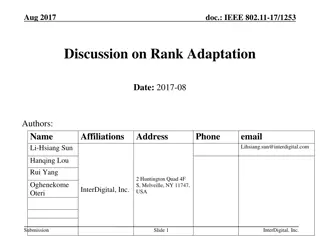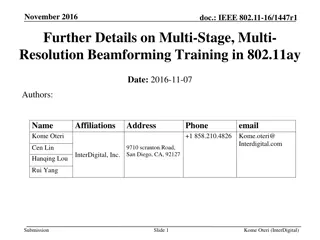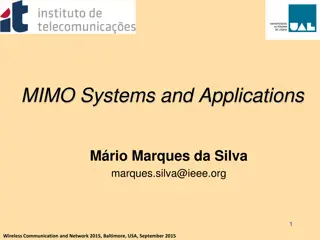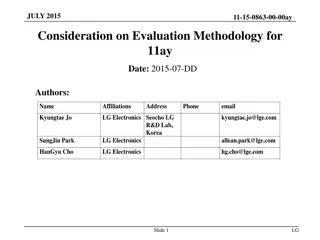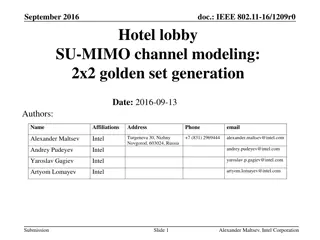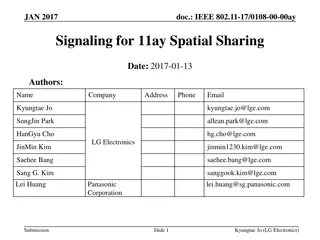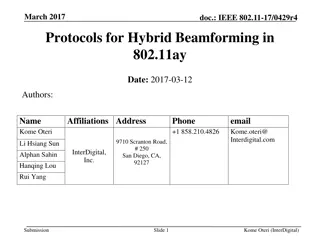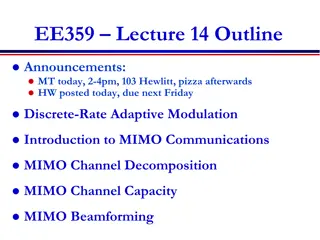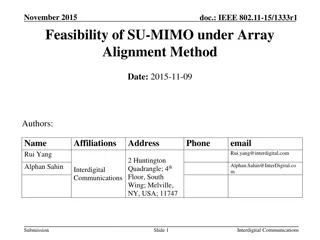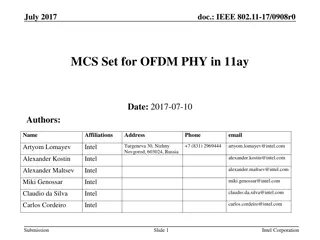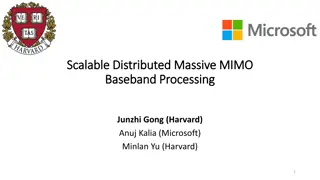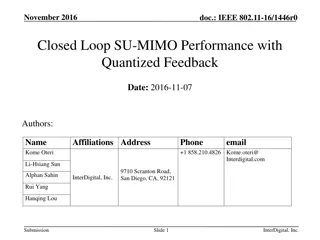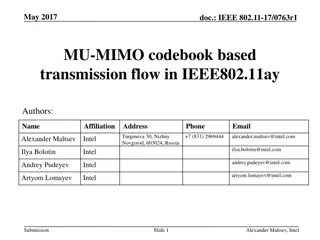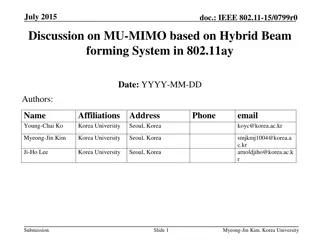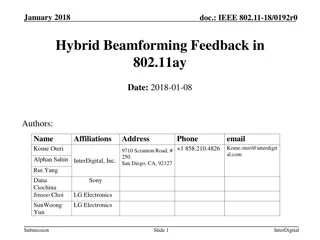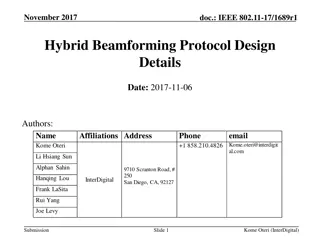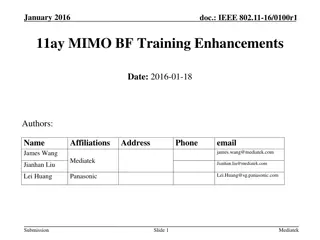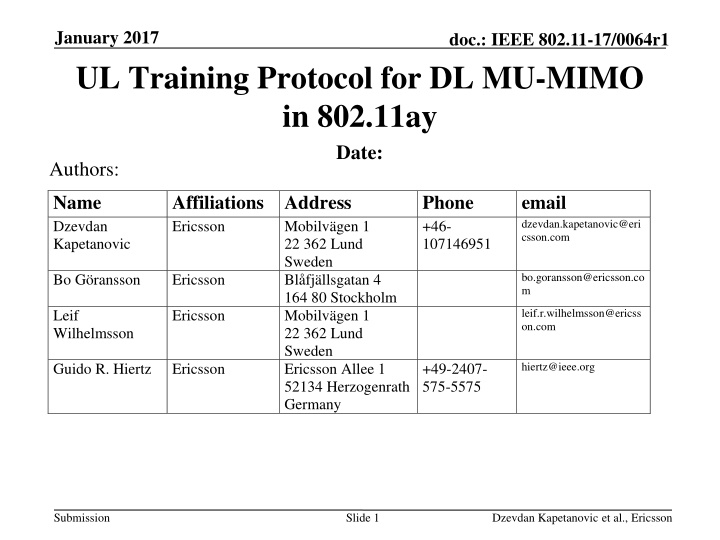
January 2017 UL Training Protocol for DL MU-MIMO in 802.11ay
Explore the January 2017 UL training protocol for DL MU-MIMO in 802.11ay by Ericsson. Discover how DL MU-MIMO works, the importance of channel information, and the hardware model considerations for optimal performance. Dive into generating transmit beams in hybrid mode and classic hybrid structure transmissions for efficient communication.
Download Presentation

Please find below an Image/Link to download the presentation.
The content on the website is provided AS IS for your information and personal use only. It may not be sold, licensed, or shared on other websites without obtaining consent from the author. If you encounter any issues during the download, it is possible that the publisher has removed the file from their server.
You are allowed to download the files provided on this website for personal or commercial use, subject to the condition that they are used lawfully. All files are the property of their respective owners.
The content on the website is provided AS IS for your information and personal use only. It may not be sold, licensed, or shared on other websites without obtaining consent from the author.
E N D
Presentation Transcript
January 2017 UL Training Protocol for DL MU-MIMO in 802.11ay Date: Authors: doc.: IEEE 802.11-17/0064r1 Name Dzevdan Kapetanovic Affiliations Address Ericsson Phone +46- 107146951 email dzevdan.kapetanovic@eri csson.com Mobilv gen 1 22 362 Lund Sweden Bl fj llsgatan 4 164 80 Stockholm Mobilv gen 1 22 362 Lund Sweden Ericsson Allee 1 52134 Herzogenrath Germany bo.goransson@ericsson.co m Bo G ransson Ericsson leif.r.wilhelmsson@ericss on.com Leif Wilhelmsson Ericsson hiertz@ieee.org Guido R. Hiertz Ericsson +49-2407- 575-5575 Submission Slide 1 Dzevdan Kapetanovic et al., Ericsson
January 2017 doc.: IEEE 802.11-17/0064r1 Introduction DL MU-MIMO is included in 11ay An essential part of DL MU-MIMO operation is the obtaining of channel information (at the AP) for proper user pairing and precoding Depending on the scenario, UL training may be more efficient (lower overhead etc.) than explicit (DL) training And vice versa Other 5G communities are adopting UL training for mmWave Submission Slide 2 Dzevdan Kapetanovic et al., Ericsson
January 2017 doc.: IEEE 802.11-17/0064r1 Hardware Model ??RF chains AP ???antennas ??? ???RF chains STA ? ????antennas ??? We consider a hybrid scenario (not fully digital) Due to this, we need to find good analog beams (SLS, BRP, etc.) before doing any digital precoding The proposed UL training mechanism is useful for both Submission Slide 3 Dzevdan Kapetanovic et al., Ericsson
January 2017 doc.: IEEE 802.11-17/0064r1 Generating Transmit Beams in Hybrid Mode Transmitting a beam ? (a.k.a. sector): ? = ?1 ?2 ?3 ?4 where ?1,?2 ?= ?1? + ?2? = ?1?1 ?2 ?3 ?4 ?+ ?2?1 ?2 ?3 ?4 ?, ?1 ?1 + ?1 ?? ?? + ?? ?? ?? + ?? ?? ?? + ?? ?1 ?? ??= ???? ??= ???? Typically RF RF Submission Slide 4 Dzevdan Kapetanovic et al., Ericsson
January 2017 doc.: IEEE 802.11-17/0064r1 Example: Classic Hybrid Structure Transmission Transmit beams/sectors corresponding to classic hybrid structure ?1 ?? RF RF ?? ??+1 ??+? RF RF ?2? ?1= ?1 ??0 0? ? ?2= 0 0 ??+1 ?2? Submission Slide 5 Dzevdan Kapetanovic et al., Ericsson
January 2017 doc.: IEEE 802.11-17/0064r1 Example: Classic Hybrid Structure Transmission Implementation A way to implement the classic hybrid transmission ?1 ?1 ?1 ?1 + + ?? ?? ?? ?? + + ?? ?? ?? ?? + + ?? ?? ?? ?? + + ?1 ?1 ?? ?? ?1 ?2 ?3 ?4 ?1 ?2 0 0 ?1 ?2 ?3 ?4 0 0 ?3 ?4 = ?1 , ?2= 0 RF RF RF RF = ?2 , ?1= 0 Submission Slide 6 Dzevdan Kapetanovic et al., Ericsson
January 2017 doc.: IEEE 802.11-17/0064r1 Generating Receive Beams in Hybrid Mode Receiving simultaneously with beams/sectors ?,? ?1 ?2 ?3 ?4 ?1 ?? ?? ?? ??= ???? ??= ???? ?1 ?? ?? ?? ? = ?1?2?3?4 ? = ?1?2?3?4 + + RF RF ? ?? ?1 ?2 ? = Submission Slide 7 Dzevdan Kapetanovic et al., Ericsson
January 2017 doc.: IEEE 802.11-17/0064r1 Example: Hybrid Structure Reception ?1 ?2 ?3 ?4 ?1 ?? ?? ?? ??= ???? ??= ???? ? = [?1?20 0] ? = [0 0 ?3?4] + + RF RF ? =? ?1 ?2 ?? Submission Slide 8 Dzevdan Kapetanovic et al., Ericsson
January 2017 doc.: IEEE 802.11-17/0064r1 Main Observations: Enhanced SLS Example Consider an AP (2 RF chains) that transmits 4 sectors to a single STA (1 RF chain) with 2 receive sectors during enhanced SLS [1] RF RF TRN-R TRN-R TRN-R TRN-R AP RF STA It takes in total 4 2 = 8 TRN-R subfield slots Submission Slide 9 Dzevdan Kapetanovic et al., Ericsson
January 2017 doc.: IEEE 802.11-17/0064r1 Main Observations: Enhanced SLS Example in UL By reversing the previous procedure, the AP can listen to 2 sectors simultaneously (since it has 2 RF chains) RF RF AP RF TRN-R TRN-R STA It takes in total 2 compared to DL) 4/2 = 4 TNR-R subfield slots (half the overhead Submission Slide 10 Dzevdan Kapetanovic et al., Ericsson
January 2017 doc.: IEEE 802.11-17/0064r1 BRP DL The previous reversal to UL training can as well be applied to the BRP procedure RF RF BRP BRP BRP BRP AP RF STA It takes in total 4 4 = 16 BRP subfield slots Submission Slide 11 Dzevdan Kapetanovic et al., Ericsson
January 2017 doc.: IEEE 802.11-17/0064r1 BRP UL We now reverse the DL BRP, so that it becomes UL BRP RF RF AP BRP BRP BRP BRP RF STA It takes in total 4 compared to BRP DL) 4/2 = 8 BRP subfield slots (half the overhead Submission Slide 12 Dzevdan Kapetanovic et al., Ericsson
January 2017 doc.: IEEE 802.11-17/0064r1 DL/UL Overhead Comparison DL training TX quantized channel estimation estimation estimation TX quantized channel channel Channel estimation and quantization TX quantized RX & process quantized channel estimation TX downlink training packet and reception at stations t RX trigger packet RX trigger packet RX trigger packet TX uplink trigger packet TX uplink training packet Channel estimation UL training Submission Slide 13 Dzevdan Kapetanovic et al., Ericsson
January 2017 doc.: IEEE 802.11-17/0064r1 DL/UL Overhead Comparison (Detailed) Hardware & scenario dependent (shaded boxes) Previous presentation showed: ???? ?? ??? + ??? ??????? #?? ???????? ????? #?? ???????? ?????= ??? ???? Implementation dependent ???< ??? ??, DL training overhead is larger Clearly, if ???? Independent of the feedback packet duration ?? In general, the larger the ??? overhead ??, the larger the DL training Submission Slide 14 Dzevdan Kapetanovic et al., Ericsson
January 2017 doc.: IEEE 802.11-17/0064r1 DL/UL Training Duality Both training methods can provide the same information about ? The DL training provides estimates of ???? fed back to AP in full form or just by indicating best beams ??? ??? ?? ? - can be ????????? ?? - directly The UL training provides estimates of ??? available at AP, no feedback needed ? and ??? calibration comes in), DL and UL training produce equivalent channel information Calibration at AP is enough to remove inter-user interference ??? (this is where ?? ??= ???? ??= ??? If ???? Submission Slide 15 Dzevdan Kapetanovic et al., Ericsson
January 2017 doc.: IEEE 802.11-17/0064r1 Impact of Channel Characteristics If complete (or almost complete) channel estimate is required, the overhead can be reduced significantly with UL training There are indoor mmWave (58.7 GHz) channels that contain significant multipaths [2] might require more than LOS estimate Submission Slide 16 Dzevdan Kapetanovic et al., Ericsson
January 2017 doc.: IEEE 802.11-17/0064r1 UL Training Protocol AP sends out a trigger frame for UL training STA 1 AP Trigger frame STA 2 STAs transmit (directional or omni) in UL (simultaneous or sequential) and AP listens to different sectors STA 1 is orthogonal to AP STA 2 Submission Slide 17 Dzevdan Kapetanovic et al., Ericsson
January 2017 doc.: IEEE 802.11-17/0064r1 Benefits of UL Training Significantly less training overhead (for same channel information) in many scenarios Requires no feedback The AP can estimate the best analog Tx-Rx beam configuration itself The AP also obtains digital CEF for the best analog Tx-Rx beam configuration (no STA feedback needed) The AP only informs STAs (during DL packet) which analog beams that they transmitted were best (so these are used as receiving beams at STAs) Submission Slide 18 Dzevdan Kapetanovic et al., Ericsson
January 2017 doc.: IEEE 802.11-17/0064r1 References [1] IEEE 802.11-17/0067r1 [2] J. Medbo, N. Seifi, H. Asplund, Frequency Dependency of Measured Highly Resolved Directional Propagation Channel Characteristics , European Wireless 2016 (invited paper) Submission Slide 19 Dzevdan Kapetanovic et al., Ericsson
January 2017 doc.: IEEE 802.11-17/0064r1 Straw Poll Do you support including the principles of Uplink training (as outlined on page 17 of this presentation) into the 802.11ay draft? Note: Inclusion into the draft is subject to the availability of normative text Yes No Further studies wanted Submission Slide 20 Dzevdan Kapetanovic et al., Ericsson



